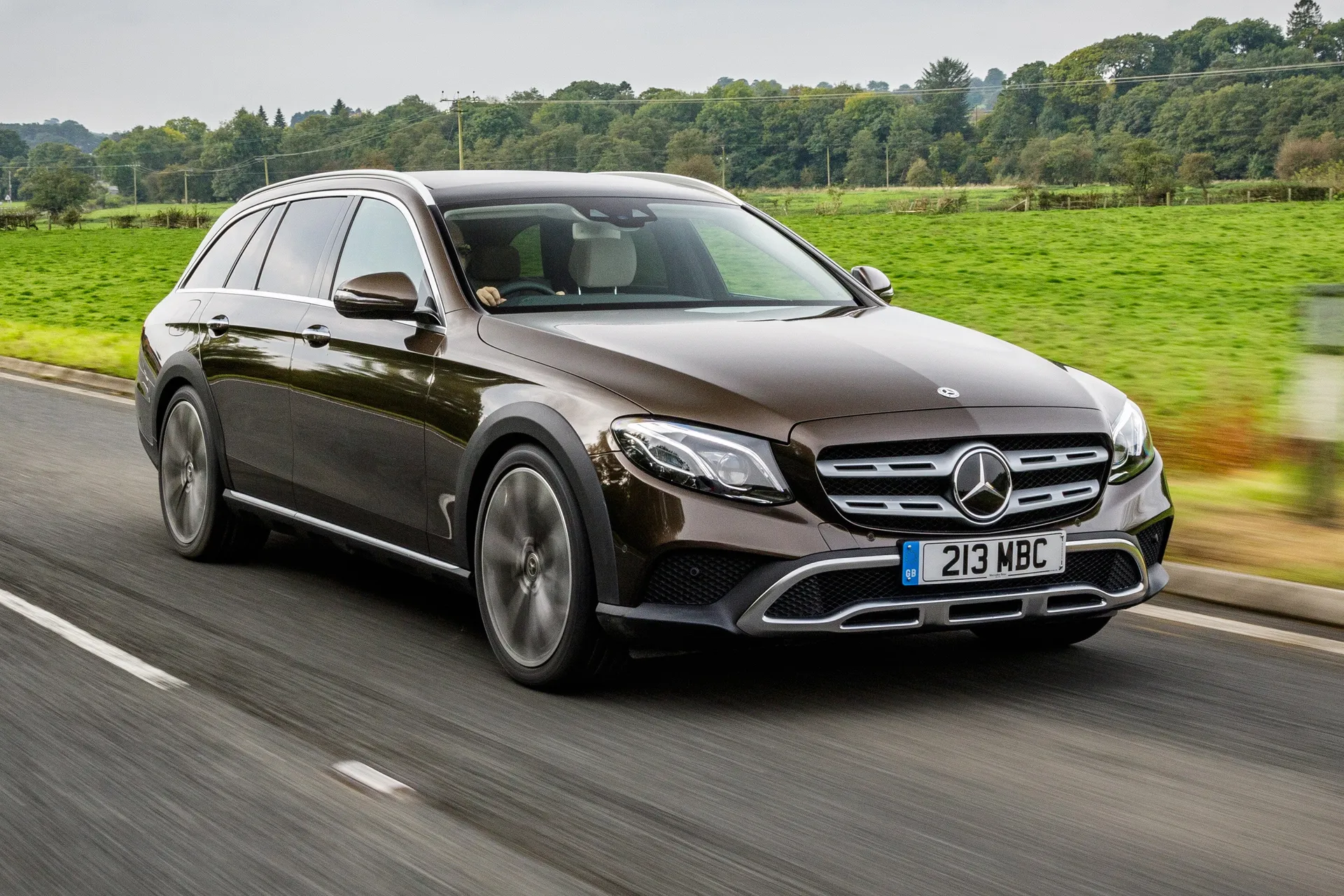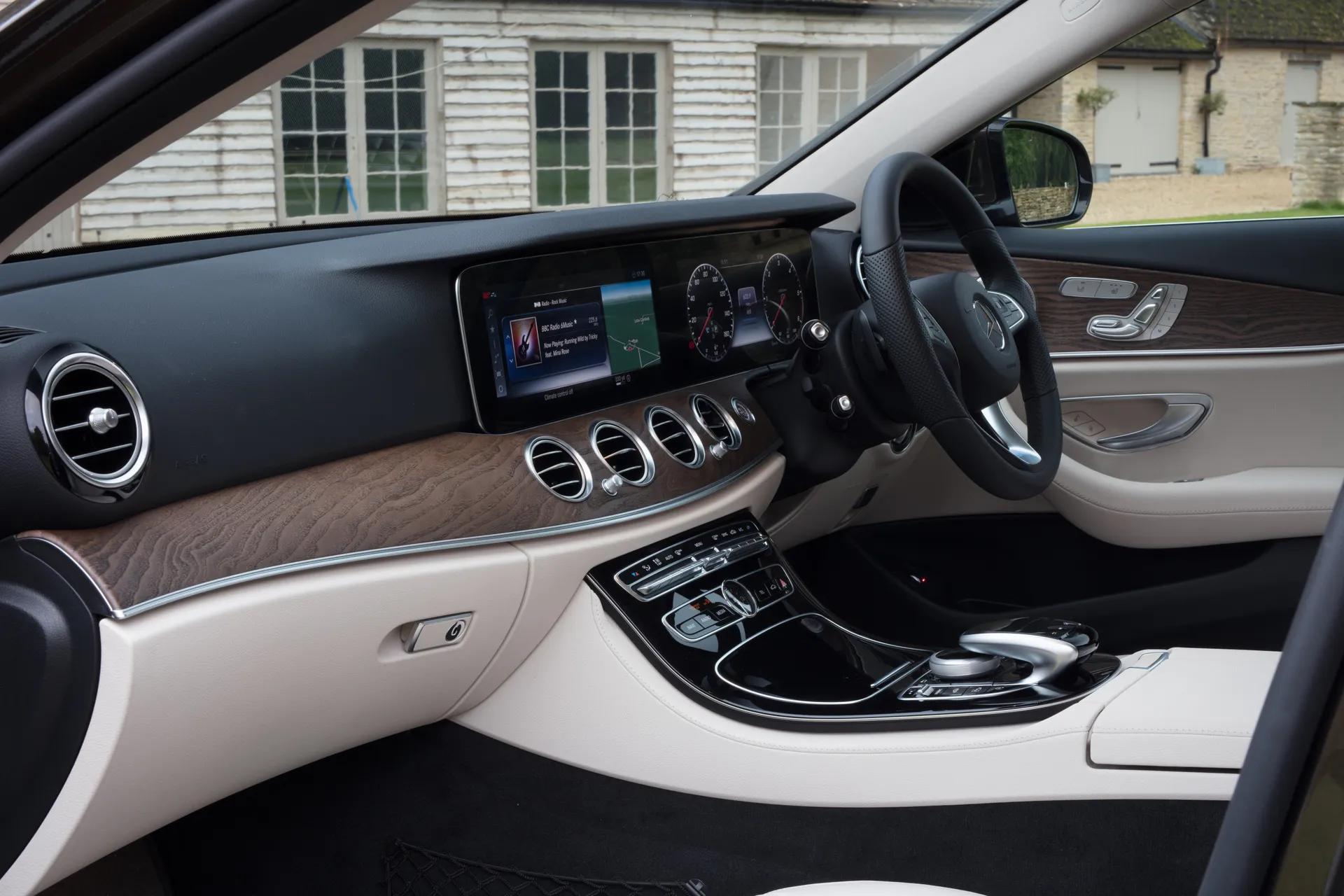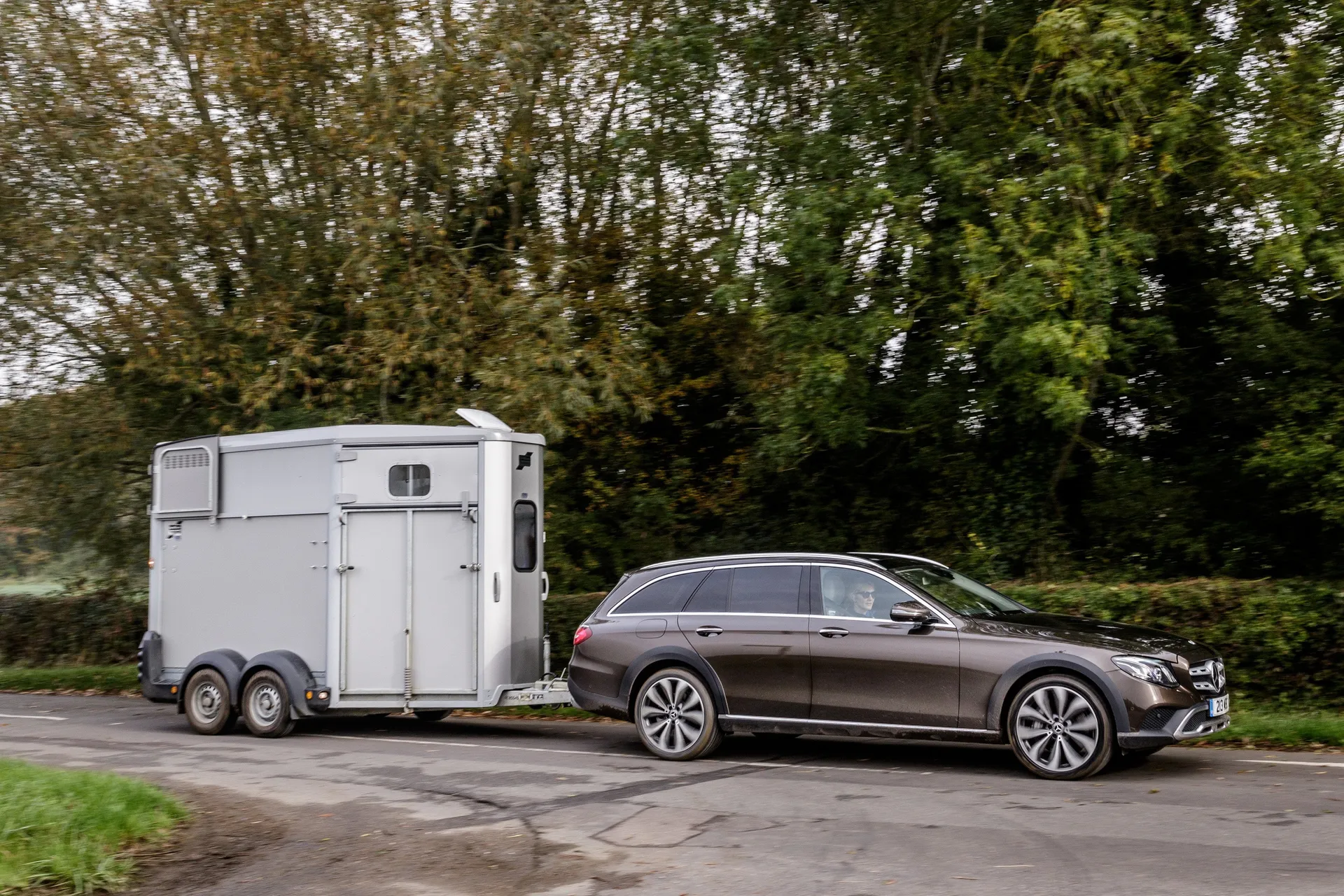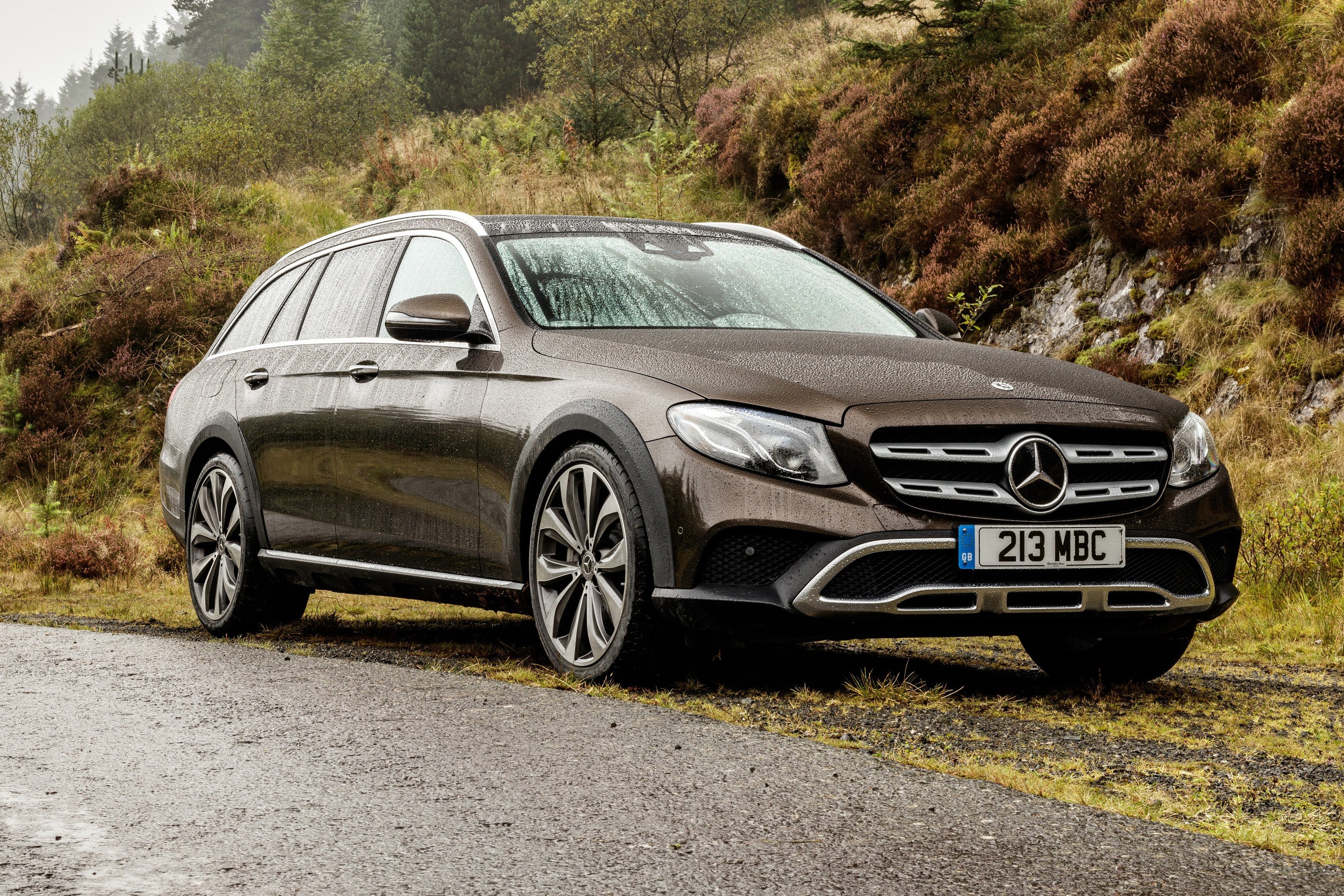Mercedes-Benz E-Class All-Terrain Review 2024
Written by Andrew Brady
Quick overview
Pros
- Versatile performance in all conditions
- Powerful and refined diesel engine
- Very high standard specification
Cons
- Unquestionably expensive
- Ride quality hurt by standard 20-inch wheels
- No engine options
Overall verdict on the Mercedes-Benz E-Class All-Terrain
"The Mercedes E-Class All-Terrain in isolation is an impressive vehicle. It’s attractive inside and out, is highly versatile both in terms of the space available and its capabilities in a variety of conditions. It has a powerful engine and transmission combination and is exceptionally well-specified."

But most of this is true for the Mercedes E-Class, which is also cheaper and can be had with a far broader range of engines, so for most people the regular model makes more sense.
Since the Mercedes E-Class Estate was launched in the 1970s, the car market has seen some big changes, in particular the rise of the SUV. Mercedes-Benz has plenty of those too, but our Mercedes-Benz E-Class All-Terrain review 2022 explains how the All-Terrain is the middle ground between SUVs and standard estates.
It’s fair to say though that this isn’t a new idea. Back in the early 2000s, Audi had the idea of putting its A6 Avant on air suspension and toughening up its looks to create the Audi Allroad. Normally German manufacturers are quick to jump on the ideas of their rivals, but it took until 2017 - for Volvo to do something similar with its V90 Estate - and for Mercedes-Benz to take the plunge and produce their own spin on an off-roading estate.
It shouldn’t take you very long to spot how the All-Terrain is visually different from the Mercedes-Benz E-Class Estate. For starters it has a higher ride height than the standard car, has unique front and rear bumpers as well as a front grille that is slatted for a tougher look, and there is grey moulded plastic around the wheel arches and the sills. It’s a partial success if you like this sort of thing, but it would be a brave soul who thought it more handsome than the regular saloon.
It’s also important to note that Mercedes-Benz claims there is just a 5% difference in parts compared to the regular E-Class Estate, so what you’re getting here isn’t particularly far removed from the original. However, what it can do, and how it performs on-road, is more different than that five per cent figure might suggest.
Unlike the regular Mercedes E-Class, the Mercedes E-Class All-Terrain is available in a single model with very few options. It shares its powertrain with the E400d, so that means you get the most powerful diesel option, a 3.0-litre turbocharged V6 putting out a mighty 340PS and 700Nm of torque.
Just like the regular Mercedes E-Class with this engine option it comes with 4MATIC four-wheel-drive as standard, giving the additional traction that buyers are looking for, but the air suspension also provides the ability to alter the ride height by 20mm at speeds below 20mph. While that isn’t going to trouble a proper off-roader, it does mean the All-Terrain can venture to places that the regular E-Class - even the four-wheel-drive versions.
The Mercedes E-Class All-Terrain offers a little extra versatility over the regular estate and for some buyers the ability to raise the suspension and head off-road will be a useful addition. However, it also adds some compromises, not least that it is very expensive. If your needs are so specific that the standard E-Class Estate or a Mercedes SUV doesn’t meet them then the All-Terrain makes sense, but that is probably a very small group of buyers.
Is the Mercedes-Benz E-Class All-Terrain right for you?
The Mercedes-Benz E-Class All-Terrain sits in a narrow window between the conventional E-Class Estate and an SUV, and not even halfway between the two either. Arguably it is a car that is designed to offer a certain style primarily and extra off-road ability as a secondary function. If you need a car that can go off-road it generally makes sense to have one that is more capable than you will ever need - just in case - and on that front the All-Terrain cannot match many proper 4x4s.
However, if you live in the countryside, or simply like the idea of looking like you do, the All-Terrain offers the right look and a reasonable dose of capability to what is already an excellent car. It is a car you could own, never wash and convince people you’re a part of the country set even if you never get within 200 yards of a horse. The vast majority of buyers will be better served by a regular E-Class Estate though.
What’s the best Mercedes-Benz E-Class All-Terrain model/engine to choose?
Mercedes certainly takes some of the decision-making stress away from you here - the Mercedes-Benz E-Class All-Terrain is essentially a trim level of its own, so there are no choices to be made - not even from the options list.
The All-Terrain is also only available with a single-engine option - the 3.0-litre six-cylinder unit found in the E400d and it’s associated four-wheel-drive system. That means it has strong performance and the ability to tow comfortably, but it also makes it an expensive car - a version with one of the smaller diesel engines would likely be popular, but for the moment at least Mercedes is sticking to the single-model approach.
The flip side of this is that the All-Terrain is loaded with equipment - it’s the only E-Class Estate that comes with a tow bar as standard, and the only option on the price list is a monthly subscription to a service plan.
What other cars are similar to the Mercedes-Benz E-Class All-Terrain?
The number of estate-SUV crossbreeds is relatively small, but they do exist. The car that kicked off the whole idea in the first place is the Audi A6 Allroad, that takes an Audi A6 Avant and builds upwards, adding a similar degree of body-toughening paraphernalia and air suspension to give a degree of off-road ability. Volvo also has its own take on this, with the Volvo V90 turning into the Volvo V90 Cross Country following similar lines - there’s even a case for Volvo being the initiator of the idea with the Volvo V70 Cross Country back in the 1990s.
Comfort and design: Mercedes-Benz E-Class All-Terrain interior
"One of the best elements of the Mercedes E-Class All-Terrain is the cabin, which is lifted almost entirely wholesale from the regular E-Class. The design itself is not in the first flush of youth, but the interior still has the ability to wow."

Unlike the perfectly fine but conservative designs you’ll find on much of the competition, the Mercedes-Benz E-Class All-Terrain has a grand, sweeping centre console that flows into a heavily-curved dashboard. If that sounds impractical, it doesn’t actually impact on the amount of space in the cabin in any significant way, and it still places all the important stuff exactly where you need it.
Another piece of good news is that the All-Terrain gets the highest specification version of the infotainment system which means a pair of 12-inch screens - one mounted centrally for infotainment purposes and another acting as the instrument display. It also includes the Comand Online elements, which gives the car a wireless hotspot for passengers to access as well as connectivity for several functions.
Getting comfortable should be the work of a moment for the driver. Because the Mercedes E-Class All-Terrain is heavily-specified as standard, you get the fancier seating package that includes electrically-adjustable seats, steering wheel and mirrors, all with memory function. Taller drivers may also find that the top of the steering wheel partially obscures the instruments, although this is less of a problem thanks to the digital instrument display.
Quality and finish
There’s little doubt that the interior of the Mercedes-Benz E-Class All-Terrain is visually impressive but the good news is that, unlike some other Mercedes-Benz products, the physical quality lives up the promise of how it looks. There’s leather on the seats and around the door and dashboard areas, which is of a good standard and feels pleasant to the touch.
Because the Mercedes E-Class All-Terrain comes in a single (and high) specification, it automatically gets the leather and matte black ash wood dashboard which is arguably the most attractive of the options. It feels good to touch and avoids feeling old-fashioned like more traditional polished brown wood can look. You do have the option of different leather colours - brown and black or a light macchiato and black, but if you plan on heading into the mud you might want to steer clear of the latter.
The overall quality of the cabin is of a high standard too, and it feels like it will last for plenty of miles. There are a couple of exceptions - some of the plastics lower down in the interior feel a little thin and insubstantial - but on the whole this feels like a well-constructed car that is built to last.
Infotainment: Touchscreen, USB, nav and stereo in the Mercedes-Benz E-Class All-Terrain
This generation of Mercedes E-Class is something of a halfway house in terms of infotainment provision, as on the one hand it has the twin 12.3-inch screen setup that was one of the first Mercedes-Benz to offer the system. However, more recent offerings like the Mercedes A-Class and Mercedes CLA models have the same screen arrangement but with added functionality and an updated control system, using a bigger and more responsive touchpad.
As standard, the Mercedes-Benz E-Class All-Terrain gets the higher specification infotainment system, which includes DAB, Bluetooth for telephony and audio streaming, sat-nav and the touchpad controller, with USB input also included. The standard Comand Online system has integrated wifi to give the system the ability to use connected services as well as allow passengers to connect devices and use the vehicle data.
The capabilities of the system are high and the graphics are slick, and there is a wide number of functions and settings so you can tailor the system to suit your needs and wants. You even have the option to choose from different design themes. What that does mean is that a little familiarity is required, and it can be a little intimidating at first.
It’s also worth noting that the control systems aren’t perfect - the touchpad and wheel on the centre console isn’t always as accurate as it could be, while the steering wheel controls are sometimes too sensitive. However, overall it is an excellent system that enhances the appeal of the car.
Space and practicality: Mercedes-Benz E-Class All-Terrain boot space
The good news is that the Mercedes-Benz E-Class All-Terrain gives nothing up in the way of space or practicality in its transformation from the standard car, so you get one of the biggest boots in the segment as well as generous space for passengers too. Front seat occupants of all heights should find it easy to get a comfortable seating position, with plenty of adjustment in the seats and the physical leg, head and elbow room, it will suit pretty much everyone.
Head for the rear seats there’s still a good amount of room, but it’s not quite as spacious as it is up front. You can fit two adults in the rear seats with ease, as headroom and elbow room are generous, but there’s a bit less legroom in comparison, so a six-footer is probably the tallest person you can comfortably fit in the back unless the front occupant has their seat rolled far forward. There is a centre seat but as is frequently the case, it’s not a full size chair so its occupant will have to contend with the transmission tunnel under their feet too. Like most cars of this size, the rear is optimised for two rather than three.
However, the rear load space is the Mercedes E-Class All-Terrain’s strongest suit. With the rear seats in place it offers a mighty 640 litres of load space - significantly more than even the Volvo V90 - while with the rear seats folded this goes up to a huge 1,820 litres, at least 100 litres more than the nearest rivals. What is more, the shape of the space is ideal, with little intrusion and a low loading lip. There’s also a false floor with a good space underneath, or optionally you can swap this for an extra pair of child seats - although it is important to remember that they are only suitable for younger children and cannot accommodate adults.
As expected the All-Terrain has a bigger footprint than the E-Class Estate at 4947mm long, 2065mm wide, and 1497mm tall, it also has a much higher ground clearance at 156mm compared to the standard 121mm.
Handling and ride quality: What is the Mercedes-Benz E-Class All-Terrain like to drive?
"The Mercedes E-Class in all its forms has traditionally offered the more comfortable option in contrast to the more sporty driving characteristics of the BMW 5 Series Touring, and with its off-road inclinations the All-Terrain model follows the same path."

In order to give the Mercedes-Benz E-Class All-Terrain that off-road ability and additional ground clearance, it is fitted with full air suspension as standard, but unlike the other models in the range it has the additional capability to raise and lower the ride height depending on the driving mode selected.
What that means for the ride quality is generally good news. Air-suspended E-Class models ride better than the other options available, although the All-Terrain model is fitted with 20-inch wheels as standard which are not ideal in terms of ride quality. The result is that the All-Terrain is somewhat fidgety on poor road surfaces at lower speeds - on smoother surfaces it rides with a good level of comfort while at higher speeds it settles down and is happy to breeze along in controlled comfort.
The handling of Mercedes E-Class All-Terrain is similar to that of the E-Class, although that higher ride height means the car’s centre of gravity is higher too, which is not a positive thing for the way a car handles.
The steering is good however, it has a reassuring weight to it and is quick to respond to inputs, giving the driver confidence. But the Mercedes E-Class All-Terrain has little enthusiasm for tackling bends. It is perfectly safe and predictable, but you are always aware of how much weight it is carrying and there is more bodyroll than on the standard car, all of which will discourage you from spending much time throwing it around.
What engines and gearboxes are available in the Mercedes-Benz E-Class All-Terrain?
Unlike the regular E-Class, the Mercedes-Benz E-Class All-Terrain is available with just a single engine and gearbox combination. The 3.0-litre six-cylinder unit that also appears in the E 400 d model, with a nine-speed automatic gearbox and 4MATIC four-wheel-drive system. For some buyers this will be something of a dealbreaker. The option to have the taller air suspension with a more efficient (and also cheaper) diesel engine in All-Terrain trim would be appealing to many, but for the moment at least this is not an option.
That said, the 3.0-litre unit in the All-Terrain is an impressive thing. Because it has six cylinders it is more refined than the 2.0-litre four-cylinder unit seen in some other E-Class models, so it is smooth even at idle speeds and is quiet when cruising. Better still is the way it performs out on the road.
With a huge 700Nm of torque available from low engine speeds, effortless acceleration is easily accessible, and with the four-wheel drive system providing maximum traction it can do so whatever the weather conditions. This also makes the All-Terrain an exceptionally capable towing car - it even comes with a tow bar as standard equipment.
The gearbox completes the package. Nine speeds might seem excessive, but it actually means smooth and swift acceleration from low revs as well as providing a very high top gear so you can cruise at higher speed with the engine at low revs. Even so, this is still a thirsty car, relatively speaking, despite the efficiency of the powertrain.
Refinement and noise levels
Mercedes-Benz has built its reputation on producing cars that offer a level of refinement above the class standard, and the Mercedes-Benz E-Class All-Terrain is right up there in this respect. The 3.0-litre diesel engine is wonderfully smooth and vibration-free, even when starting from cold and while on the move it spins quietly.
The rest of the E-Class All-Terrain package also contributes to the overall levels of refinement, and the quality of the build and materials is reflected in how quiet the cabin is.
Even on the occasions when you can hear the engine working hard, it sounds distant rather than up close, and that makes for a relaxing experience for the cabin occupants. Road noise levels are quite well contained, although versions with bigger wheels tend to create a little more noise. Despite the frameless windows, wind noise is also well controlled, with just a little generated by the door mirrors at higher speed. Overall, the E-Class offers an impressive level of refinement - it’s one of the best in the class.
Safety equipment: How safe is the Mercedes-Benz E-Class All-Terrain?
Euro NCAP tested the Mercedes E-Class in 2016, and although the test was conducted on a saloon, the organisation ruled that the score was relevant to all E-Class and CLS variants.
The E-Class was awarded the maximum five stars, including an impressive 95% score for adult protection and 90% for child protection. The pedestrian rating of 77% was also strong, although the safety assist rating of 62% compares less favourably with newer Mercedes-Benz models and some of the competitors - the age of the E-Class is a contributing factor here.
However, it is important to note that specifications change regularly and that the E-Class has more safety equipment as standard than when it was first tested in 2016. All E-Class models are fitted with front chest and side airbags, a knee airbag for the driver and curtain airbags, an active bonnet, blind spot assist, the Mercedes-Benz Pre-Safe system that prepares the car if it detects an accident is imminent, traffic sign assist, and ESC.
The Driving Assistance Plus package can be added, which includes active blind spot assist, active braking assist with cross-traffic function, Pre-Safe Plus and active emergency stop assist amongst other features, but this can only be specified on the AMG Line Night Edition Premium Plus, the All-Terrain Edition and the Mercedes-AMG E53 model.
MPG and fuel costs: What does a Mercedes-Benz E-Class All-Terrain cost to run?
"Although it has a range of efficient engines, the E-Class Estate is still a big and quite heavy car. The All-Terrain also packs the most powerful diesel engine and incorporates the four-wheel-drive system, so it is also at the heavier end of the scale."

The claimed consumption figure for the Mercedes-Benz E-Class All-Terrain is 38.7mpg, which is not only relatively poor for a car like this but is also significantly worse than the 42.2mpg figure for the regular E-Class E 400 d which shares the same powertrain.
How reliable is the Mercedes-Benz E-Class All-Terrain?
In recent HonestJohn.co.uk Satisfaction Index reports Mercedes-Benz have missed the mark on reliability, averaging 8.92 out of 10 in the latest survey. However, out of 30 manufacturers Mercedes sat in the middle of the pack with 87.9% overall satisfaction.
Insurance groups and costs
With just a single model in the range with a high specification and one of the most powerful engines available, it should come as no surprise to learn that the Mercedes-Benz E-Class All-Terrain falls into a high insurance group. At group 44 it is the same as the regular E400d E-Class Estate, but this is still the as the high-performance E53 AMG model. Even if you are an older driver with a good driving record you can expect a high premium, adding to what is already an expensive car.
VED car tax: What is the annual road tax on a Mercedes-Benz E-Class All-Terrain?
The VED rate on a new Mercedes-Benz E-Class All-Terrain is compounded by a list price in excess of £40,000 and CO2 emissions that fall into the second-highest band. That means that when buying new you have to pay a massive £1,850 in the first year, and £475 for years two to five inclusive after that. This is the same for the regular Mercedes-Benz E-Class Estate with this engine, but nonetheless it is a significant extra expense compared with less-powerful diesel options in the conventional E-Class Estate.
How much should you be paying for a used Mercedes-Benz E-Class All-Terrain?
"The Mercedes All-Terrain E-Class has not been on sale as long as the regular E-Class, and as it is a somewhat niche model there are far fewer examples on the market. However, this relative rarity hasn’t adversely affected prices. Because it is so expensive to buy in the first place, depreciation is quite heavy and means there are bargains to be had."

A search of the classifieds turned up several 2019-registered examples with low mileage - many had fewer than 10,000 miles on the clock so would still have plenty of manufacturer warranty left. We found a 2019 car in black with less than 6,000 miles on the clock for £43,000 - a saving of almost £20,000 over the list price of a new car. The earliest car we found was from 2018, had less than 30,000 miles and was selling for £35,000.
Trim levels and standard equipment
The Mercedes-Benz E-Class All-Terrain comes with effectively a complete specification with no options, which includes sat-nav, air suspension, Easy-Pack automatic tailgate, Parking Pilot including Parktronic and reversing camera, chrome roof rails, 64-colour selectable LED interior lighting, Keyless-Go starting function, heated front seats, DAB radio and 20-inch alloys, Comand Online, Keyless-Go Comfort package, Memory package and a panoramic glass sunroof, Burmester surround sound system with 13 speakers and a Multibeam LED Intelligent Light System.
Ask the heycar experts: common questions
What is a Mercedes-Benz E-Class All-Terrain?
Does the Mercedes-Benz E-Class have all-wheel drive?
Does the Mercedes-Benz E-Class Estate All-Terrain have air suspension?
Get our latest advice, news and offers
Keep me updated by email with the latest advice, news and offers from heycar.
By submitting you agree to our privacy policy



